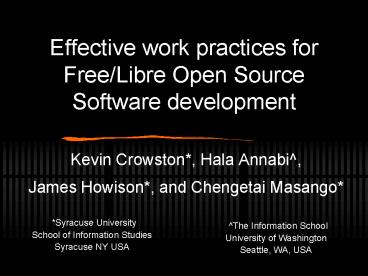Effective work practices for FreeLibre Open Source Software development - PowerPoint PPT Presentation
1 / 15
Title:
Effective work practices for FreeLibre Open Source Software development
Description:
Effective work practices for Free/Libre Open Source Software development ... of socialization, conversation and narration will display more highly developed ... – PowerPoint PPT presentation
Number of Views:57
Avg rating:3.0/5.0
Title: Effective work practices for FreeLibre Open Source Software development
1
Effective work practices for Free/Libre Open
Source Software development
- Kevin Crowston, Hala Annabi,
- James Howison, and Chengetai Masango
Syracuse UniversitySchool of Information
StudiesSyracuse NY USA
The Information SchoolUniversity of
WashingtonSeattle, WA, USA
2
Overview of talk
- Interdisciplinary software engineering
- Study of work practices for OSS
- Research questions
- Theories
- Study design
3
Domain of software engineering
4
Software engineering and related disciplines
Software Engineering
Information Systems
5
What is FLOSS?
- FLOSS Free/Libre Open Source Software
- Software distributed under license that allows
inspection, modification and redistribution of
the source code - AKA free or libre software
- Free as in speech vs. free as in beer
- Examples Linux, Apache, gcc, sendmail,
X-windows, GNOME, GAIM, OpenOffice, etc. - as well as many lesser-known projects
6
Why FLOSS is interesting for this workshop
- Mostly developed by distributed teams of
volunteers coordinated via the Internet - Conways law Structure of the software reflects
the structure of the team that develops it - Implies that distributed teams should have
trouble creating integrated software - Successful FLOSS teams somehow overcome problems
of distributed software development
7
Overall research question
- What work practices make some FLOSS teams more
effective than others? - Issues
- What do we mean by effective?
- What practices should we look for?
8
Effectiveness Success measures in IS
- DeLone McLean (1992)
- Seddon (1997) system quality, information
quality, perceived usefulness, user satisfaction,
and IS use
Difficult to observe, especially for FLOSS
9
Effectiveness II Our success model
User Co-developers Contribution
User Feedback
System Creation
System Use
System Consequences
- User-base
- Downloads
- One-off event vs. often and early
- Completion vs. Progress of process
- Number of developers
- Developer Satisfaction (developers are often
users) - Meets development goals
10
Effectiveness IIIHackmans Team Effectiveness
Model
Coordinationtheory
Collective mind
11
Practices of interest
- Coordination of task
- Social structures of communication and
development - Member recruitment
- Development of norms (e.g,. through
socialization) - Development of collective mind
12
Practices ITask Structure coordination theory
- Task structure as key input
- Malone and Crowston
- actors in organizations face coordination
problems arising from interdependencies that
constrain how tasks can be performed
Proposition Teams with task structures and
practices that minimize dependencies will be more
effective.
Proposition Teams with coordination practices to
manage dependencies will be more effective.
13
Practices IITeam synergy Collective Mind
- Addressing Team Synergy through Collective Mind
- Subordination (Alignment)
- Contribution
- Representation
Proposition Teams with more highly developed
shared mental models will be more effective.
Proposition Teams which are able to align
individual goals and team goals will be more
effective.
14
Practices IIISocialization Participant
Observation
- In depth participant observation study of Plone,
a content management system - Importance of IRC, conferences and sprints
- Core team referred to as authority
- Those with aligned commercial purposes (eg web
designers) move quickest to centre - Socialization through rich references to geek
culture (Star Wars, Ghostbusters, Snowcrash )
Proposition Teams with higher levels of
socialization, conversation and narration will
display more highly developed shared mental
models.
15
Expanding the WISER framework
- Information Systems as a column
- Process modeling and coordination theory for
manageable processes - Alignment of Communication/Management and
artifact/core structures - Consider open systems as issue/problem row
- Project management of open source and inner
source - Attracting and retaining quality developers
- Managing/motivating non-employees
- Managing Intellectual Property risks































